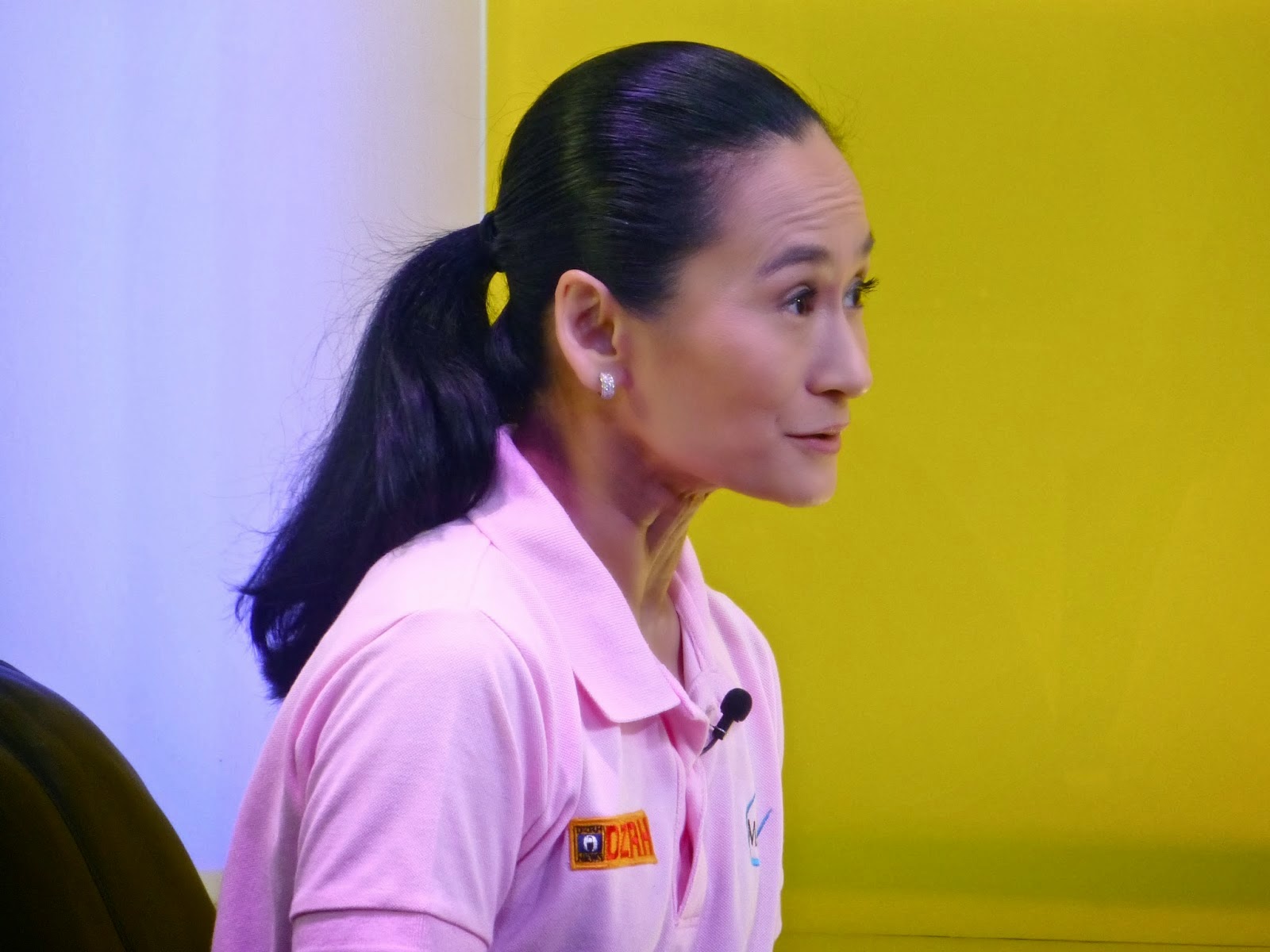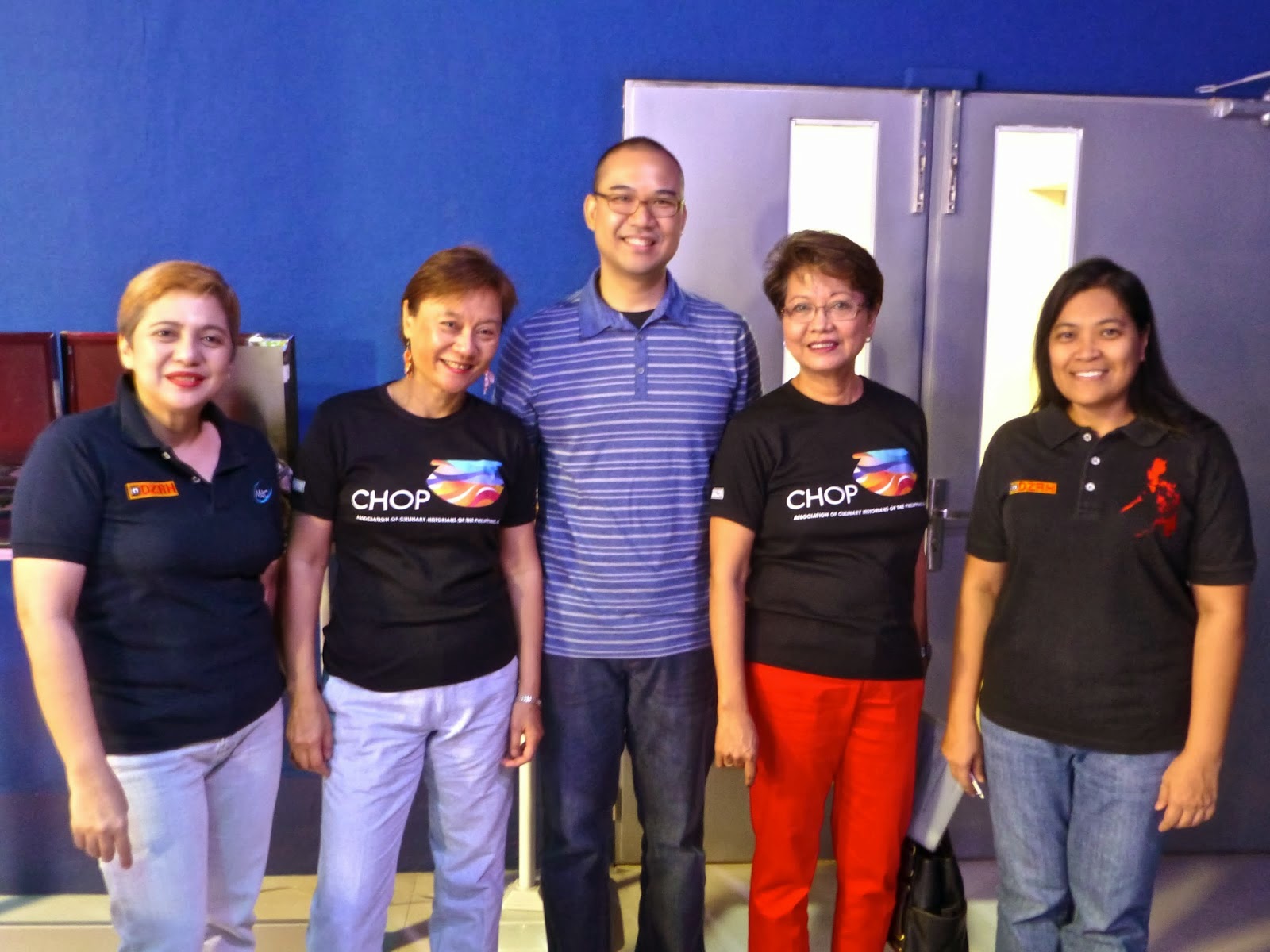TV/Radio Interview with Lisa Macuja (February 10, 2014)
The
following text is from Ian Newport’s blog:
The
TV/radio program Art 2 Art, hosted by Lisa Macuja,
interviewed CHOP (Culinary Historians of the Philippines)
officers Regina Tolentino Newport (President), Pia
Lim-Castillo (Vice President) and Alvin Reyes Lim (Assistant
Vice President) about the founding and the history of the group, its vision and
objectives, and its various activities and sponsored events.
Lisa
Macuja, the
renowned prima ballerina of Manila Ballet, started this
program four years ago to explore the power of broadcasting in pursuing her
mission to develop a greater appreciation for art and culture among fellow
Filipinos. She has interviewed hundreds of local artists.
The
interview was produced in the studios of the Manila Broadcasting Company (MBC)
and came about when MBC's Susan de Guzman (Program Consultant) read
CHOP member Ige Ramos' Bandera column about CHOP's recent Binondo
Wok Tour. Susan contacted Regee and asked whether she would be willing
to be interviewed for the Art 2 Art program. Regee happily agreed, provided she
could bring her fellow CHOP colleagues, Pia and Alvin.
Here are
the CHOP "stars" with Producer/Editor Anjie Ureta
on the far left and Susan de Guzman on the far right just before
the interview. They explained the whole set up and how the interview
would be conducted. They were so welcoming and helpful and even had
excellent coffee on tap.
I was
brought along at the last moment as "moral support" for Regee. This
mainly involved drinking coffee, keeping out of the way and serving as the
back-up still camera man. As most of the interview was in Tagalog, I cannot
pretend that the following is a totally accurate account of what was going on.
For a
better understanding, I suggest you watch the interview--and have your Tagalog
dictionaries at the ready!
They told
us that the interview would air on Sunday, March 9, at 3.30-4 pm on DZRH
(666khz on AM radio) and on RHTV cable TV. You can also see it
simultaneously on the internet through DZRH Live Streaming at www.dzrh.com.ph.
When we
arrived, Lisa was busily reading up on CHOP and preparing her questions for the
interview. The TV studio was really impressive and the technicians were
busy setting everything up for the interview.
The next
step was to get "wired up" without the wires being too obvious.
Everybody promptly got tangled in wires but with a little help from the professionals
nobody got strangled before they went on the air.
I have to
say that all three CHOP "stars" were a little nervous about being
interviewed on TV--even if the taping was not done in front of an audience.
However, with the wonderful openness and warmth of interviewer Lisa
Macuja, they were all put at ease immediately. When Lisa started asking
questions about CHOP, they all responded in a very relaxed and natural fashion
and as the interview proceeded you could see that they were positively enjoying
themselves.
Lisa opened
with some questions about CHOP's mission and how it was organized. She
then launched into some penetrating questions about CHOP's objectives, research
techniques and whether you really had to be a food expert, chef, or an academic
"historian" to be a member of CHOP.
Regee
assured Lisa that "none of the above" were requirements. On the
contrary, all the members of CHOP, whatever their backgrounds or professions,
were just people who were interested in learning more about the diverse history
of Philippine cuisine. What they had in common was a strong belief in the
promotion and preservation of our own food, ingredients and methods of cooking;
and a desire to "give back" by participating in culinary-based
advocacy programs.
The name
"Culinary Historians" came from sister organizations that have been
established for many years in a number of big U.S. cities. Regee is a
long-standing member of the Culinary Historians of Washington D.C.
(CHOW DC). They gave her their enthusiastic support to
establish CHOP in Manila. CHOP members, just like CHOW DC members, are
not "historians" in the academic or scholarly sense of the word--they
were more "students" who want to learn the history of food in their
own countries and globally.
Pia went
on to explain that in an archipelago of over 7,000 islands, there was an
amazing diversity of dishes, cooking techniques, ingredients and, consequently,
many fascinating regional variations of basic dishes. In addition, you
had to understand the many profound influences on our culinary heritage from
regional neighbors such as China, Malaysia, Indonesia and Thailand; and the
important role that colonial Spain and Mexico had played in that heritage.
Taking
pride in that diversity and exploring the historical influences at play in our
culinary heritage made for a fascinating area of study.
Lisa spoke
several times of her interest in the "research" part of CHOP's work,
and she was told by her three guests that they would very much welcome her to
the CHOP family.
Lisa
wanted to know what was the signature indigenous Philippine dish. The
CHOP officers had a lot to say on this matter. The two principal
contenders for that honor were Adobo and Sinigang. There were a lot of
factors to be taken into account but, on balance, the prize would probably go
to Sinigang (as Doreen Fernandez suggested in one of her many articles on our
cuisine), even though Adobo is more internationally known. Numerous versions of
both dishes are immensely popular throughout the country.
Why does
Sinigang get the prize? Probably because it is the dish that does not
have any "imported" ingredients (unlike Adobo that has soy sauce
which is definitely not indigenous). Sinigang has a number of indigenous
"souring" agents--which vary depending upon different regions and the
ingredients available. So, Sinigang may be "soured" by
tamarind, santol, kamias, calamansi, guava, unripe mango etc--all of which are
indigenous--as are the usual proteins (fish, pork) and vegetables (kankong,
sitaw, talong etc).
Lisa asked
about CHOP's planned activities and events for 2014. Pia said that on
January 25, she organized a Binondo Wok Tour with Ivan Man Dy (CHOP member and
co-owner of Old Manila Walks). Ivan had tailored the tour with CHOP's purposes
in mind, and the large group of 36 nibbled their way through historic Chinatown
and learned much about Chinese influences in our cooking and culture. By the
time this segment airs on March 9, CHOP will have done a Coastal Cavite Tour
set for March 1, which is being organized by Pia with CHOP member and food
writer Ige Ramos. Other food trips are being planned for Quezon, Malolos,
and Pampanga in the next few months.
CHOP will
also have a lecture series for the latter part of the year, which Alvin is
organizing. This will include, initially, talks by experts on rice, coconut and
virgin coconut oil, sawsawan, and the work of the Kawali Kings of Enderun
Colleges headed by CHOP member Erwin Lizarondo.
On the
advocacy role of CHOP, Alvin outlined several areas that the group was looking
into, but that CHOP needed first to raise enough funds to finance such
projects. The focus right now is on the search for donors who would support the
group's objectives.
At the end
of the interview, we all gathered together for a final "still" of the
whole group. Regee had been very insistent that we all wear our CHOP
T-shirts but Alvin and I resisted revealing them under our ordinary shirts
because they were too small for us. Anyway, for better or for worse, we
were made to "undress" and here we are in our CHOP attire. Much
laughter, good humor and, hopefully, a great interview. We'll find out on
March 9. Don't forget to watch!
Photo Gallery













No comments:
Post a Comment